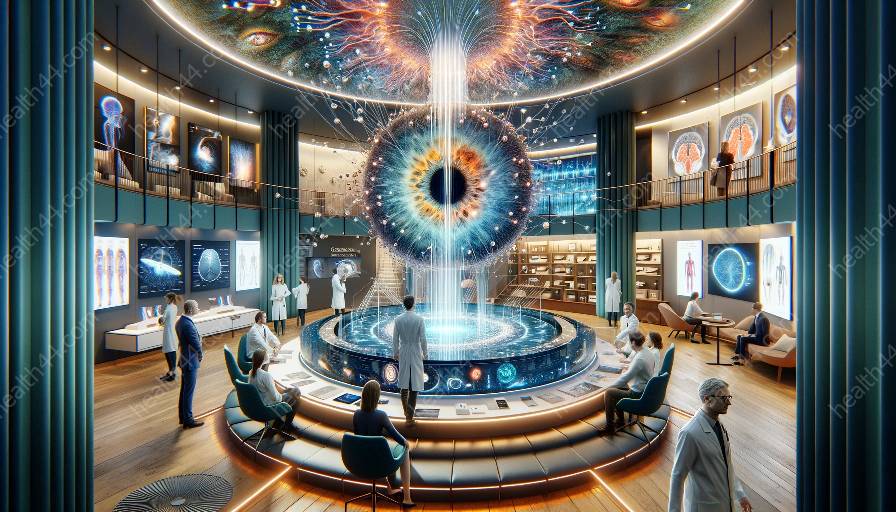Creating accessible environments for individuals with visual impairments is crucial in enhancing their quality of life. It involves thoughtful considerations that benefit those with different levels of visual impairment. A comprehensive approach, integrating both visual perception and vision rehabilitation, is essential to effectively create inclusive and accessible spaces for individuals with visual impairments.
Understanding Visual Impairments
Visual impairments encompass a wide range of conditions that result in reduced or loss of vision. These conditions may include but are not limited to, total blindness, low vision, and color blindness. It's important to recognize that individuals with visual impairments have diverse needs and abilities, and creating accessible environments requires a deep understanding of these varying requirements.
Visual Perception and Accessibility
Visual perception plays a pivotal role in the design of accessible environments for individuals with visual impairments. Understanding how individuals with visual impairments perceive and interact with their surroundings is essential in creating inclusive spaces. Factors such as contrast, lighting, and texture can greatly impact the visual perception of individuals with impairments, and incorporating these elements into the environment can enhance accessibility.
Contrast and Color Considerations
Contrast is a key aspect of visual perception for individuals with impairments. Ensuring adequate contrast between objects, such as furniture and walls, as well as text and background, can facilitate better visibility for individuals with visual impairments. Additionally, considering color combinations that are easily distinguishable can further enhance accessibility.
Lighting and Visibility
Proper lighting is critical in creating accessible environments. For individuals with visual impairments, adequate lighting can improve visibility and reduce the risk of accidents. Implementing glare-reducing fixtures and incorporating natural light where possible can contribute to enhancing visibility for individuals with visual impairments.
Texture and Tactile Indicators
Introducing tactile indicators and textured surfaces in the environment can aid individuals with visual impairments in navigating spaces effectively. Tactile indicators, such as braille signage and textured flooring, provide essential cues that contribute to the accessibility and safety of the environment.
Integrated Approach: Vision Rehabilitation
Vision rehabilitation is a vital component in creating accessible environments for individuals with visual impairments. Vision rehabilitation encompasses a range of services and interventions aimed at optimizing visual functioning and promoting independence for individuals with visual impairments. By integrating vision rehabilitation into the design of environments, it becomes possible to address the specific needs and capabilities of individuals with visual impairments.
Orientation and Mobility Training
Orientation and mobility training is a core element of vision rehabilitation. This training equips individuals with skills and techniques to navigate and orient themselves in various environments. When designing accessible spaces, incorporating features that support orientation and mobility, such as tactile paths and auditory cues, can significantly benefit individuals undergoing vision rehabilitation.
Assistive Technology and Accessibility
Advancements in assistive technology have revolutionized accessibility for individuals with visual impairments. Integrating these technologies into environments, such as audible signage and accessible digital interfaces, can enhance independence and participation for individuals undergoing vision rehabilitation.
Collaborative Design and Consultation
Collaboration with vision rehabilitation specialists and individuals with visual impairments is essential in the design process. Their insights and experiences can offer valuable perspectives that inform the creation of truly accessible environments. By involving these stakeholders, the design of spaces can align more closely with the needs and preferences of the end users.
Putting Theory into Practice: Practical Approaches
When implementing strategies to create accessible environments for individuals with visual impairments, several practical approaches can be adopted to ensure inclusivity and accessibility.
Universal Design Principles
Adopting universal design principles facilitates the creation of environments that are accessible to individuals with diverse abilities, including those with visual impairments. Features such as step-free entrances, clear signage, and auditory information enhance the usability of spaces for everyone.
Multi-Sensory Experiences
Engaging multiple senses in the design of environments can enrich the experience for individuals with visual impairments. Incorporating elements such as tactile exhibits, audio descriptions, and aromatherapy can create inclusive and stimulating environments that cater to diverse perceptual abilities.
Accessibility Audits and Feedback
Conducting regular accessibility audits and seeking feedback from individuals with visual impairments can provide valuable insights for improving the accessibility of environments. By actively engaging with the users, it becomes possible to address specific challenges and enhance the overall accessibility of spaces.
Empowering Inclusivity and Participation
Creating accessible environments for individuals with visual impairments is a fundamental step in promoting inclusivity and participation. By prioritizing visual perception and integrating vision rehabilitation principles, environments can be designed and adapted to meet the diverse needs of individuals with visual impairments. Through collaborative efforts and a commitment to inclusivity, it becomes possible to create environments that empower independence and facilitate meaningful engagement for all individuals, regardless of their visual abilities.
Conclusion
Creating accessible environments for individuals with visual impairments requires a holistic approach that considers both visual perception and vision rehabilitation. By prioritizing elements such as contrast, lighting, texture, and integrated vision rehabilitation strategies, it becomes possible to design environments that are inclusive and accessible. Through the adoption of universal design principles, multi-sensory experiences, and active engagement with stakeholders, the process of creating accessible environments can contribute to empowering individuals with visual impairments and promoting their full participation in various settings.





















